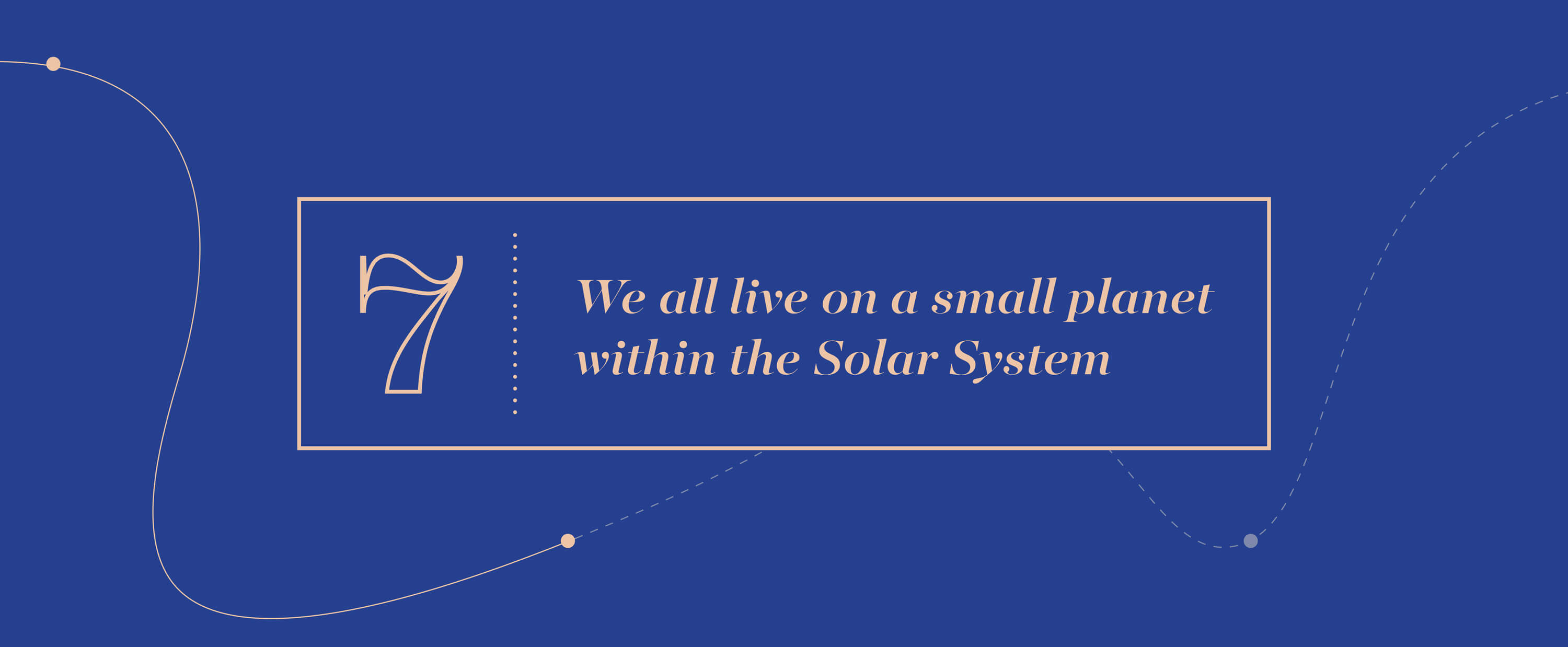
7.1
The Solar System was formed about 4.6 billion years ago
Radioactive dating of meteorites has allowed us to determine the age of the Solar System. This age is also consistent with the dating of lunar rock samples and the oldest rocks found on Earth’s surface.
7.2
The Solar System is composed of the Sun, planets, dwarf planets, moons, comets, asteroids, and meteoroids
Our Solar System consists of a central star that we call the Sun and of every object in its orbit, under the influence of its gravity. These objects include planets and their natural satellites, dwarf planets, asteroids, meteoroids and comets. The Sun accounts for more than 99.87% of the Solar System’s total mass.
7.3
There are eight planets in the Solar System
According to the 2006 International Astronomical Union resolution, in order for an object to be a planet it must fulfil three criteria. The first is that it must orbit the Sun. The second is that a planet must have enough mass for gravity to transform it into an approximate spherical shape, and finally, its gravitational influence must be sufficient so as to clear its orbital neighbourhood from other objects. Objects that are not moons and obey the first two rules, but not the third, are called dwarf planets. Counting from the Sun, the planets in our Solar System are Mercury, Venus, Earth, Mars, Jupiter, Saturn, Uranus and Neptune.
7.4
There are several dwarf planets in the Solar System
Dwarf planets are all smaller than Earth’s Moon, which has a diameter of about 3474 kilometres. Pluto is currently the largest of the dwarf planets, followed by Eris, Haumea, Makemake and Ceres. Each of these objects are solid, with icy surfaces, and have similar compositions. Ceres is located between the orbits of Mars and Jupiter, while the other four dwarf planets can be found beyond Neptune’s orbit, in the Edgeworth-Kuiper belt.
7.5
The planets are divided into terrestrial (rocky) planets and gas giants
The four planets closest to the Sun are called terrestrial planets. All of these planets have a solid surface and are composed mostly of rock. Mercury has no atmosphere but compared to Earth, Venus has the densest atmosphere and Mars the thinnest atmosphere. In contrast with the small inner planets, the four outer planets, which are called gas giants, are much larger. These planets are mainly gaseous (hydrogen and helium) and their atmospheres are very dense. All the gas giants have rings around them. Saturn has by far the most impressive ring system, which is visible even through a fairly small telescope.
7.6
Some planets have dozens of natural satellites
With the exception of Mercury and Venus, all planets have at least one natural satellite. Earth is the only planet in the Solar System which possesses only one moon, while Mars has two moons. Contrasting with the terrestrial planets, all the gas giants have a great number of objects orbiting them. With over 75 confirmed moons each, Jupiter and Saturn are the planets with the most natural satellites, followed by Uranus and Neptune.
7.7
Earth is the third planet orbiting around the Sun, and has one natural satellite, the Moon
Our home planet is the third planet counting from the Sun and has an almost circular orbit. Earth’s atmosphere is mainly composed of nitrogen and oxygen and the average temperature at its surface, which is covered for over 70% by water, is about 15 degrees Celsius. The Moon is Earth’s only natural satellite and the only celestial object upon which humans have set foot.
7.8
There are millions of asteroids, which are remnants from the early formation of our Solar System
Remnants from the early formation of the Solar System can be mainly found in the asteroid belt, located between the orbits of Mars and Jupiter, and the Edgeworth-Kuiper belt, located beyond Neptune’s orbit. These asteroids range in size from about 10 metres to 1000 kilometres and the combined mass of all the asteroids in the Solar System is less than the mass of Earth’s Moon.
7.9
A comet is an icy object that acquires a tail when it is heated by the Sun
Comets are mainly composed of ice, but they also contain dust and rocky material. The ice is volatile and evaporates when the comet approaches the Sun due to solar winds and radiation. This creates two tails – a dust tail that is slightly bent in the direction opposite to the comet’s movement, stretching for millions of kilometres, and a plasma tail which is straight and not often visible to the unaided eye. The comet’s tails always point in the opposite direction of the Sun, independently of the direction the comet is moving. Most comets are believed to come from two specific regions: the Edgeworth-Kuiper Belt, located beyond Neptune’s orbit, and the Oort Cloud, at the edges of the Solar System.
7.10
The boundary of the Solar System is called the Heliopause
The magnetic field of the Sun stretches out far beyond its surface. This creates a bubble that encases the entire Solar System. The region where the magnetic field of the Sun interacts with the magnetic field of other stars is called the Heliosheath. The outer boundary of this roiling, turbulent region is called the Heliopause. Beyond the Heliopause lies interstellar space. In 2012, spacecraft Voyager 1 was the first human-made object to cross the Heliopause.
